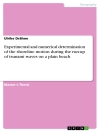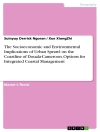Efficient and equitable policies for managing disaster risks and adapting to global environmental change are critically dependent on development of robust options supported by integrated modeling.
The book is based on research and state-of-the art models developed at IIASA (International Institute for Applied Systems Analysis) and within its cooperation network. It addresses the methodological complexities of assessing disaster risks, which call for stochastic simulation, optimization methods and economic modeling. Furthermore, it describes policy frameworks for integrated disaster risk management, including stakeholder participation facilitated by user-interactive decision-support tools.
Applications and results are presented for a number of case studies at different problem scales and in different socio-economic contexts, and their implications for loss sharing policies and economic development are discussed. Among others, the book presents studies for insurance policies for earthquakes in the Tuscany region in Italy and flood risk in the Tisza river basin in Hungary. Further, it investigates the economic impact of natural disasters on development and possible financial coping strategies; and applications are shown for selected South Asian countries.
The book is addressed both to researchers and to organizations involved with catastrophe risk management and risk mitigation policies.
Table of Content
Preface .- PART I. Integrated Modeling for Informing Risk Management Policies.- 1. Integrated Modeling for Informing Risk Management Policies: An Introduction.- 2. Modeling Risk and Uncertainty: Managing Flash Flood Risk in Vienna.- 3. Modeling Catastrophe Risk for Designing Insurance Systems.- 4. Handling Multiple Criteria in Flood Risk Management.- 5. Dams and Catastrophe Risk: Discounting in Long-Term Planning.- PART II. Disasters and Growth: Modeling and Managing Country-wide Catastrophe Risk.- 6. Modeling Aggregate Economic Risk: An Introduction.- 7. Catastrophe Risk and Economic Growth.- 8. Modeling Macro-scale Disaster Risk: The CATSIM Model.- 9. Managing Indirect Economic Consequences of Disaster Risk: The Case of Nepal.- PART III. Tisza River Basin in Hungary: Flood Risk Management, Multi-Stakeholder Processes and Conflict Resolution.- 10. Catastrophe Models and Policy Processes: Managing flood Risk in the Hungarian Tisza river basin. An introduction.- 11. Social Indicators of Vulnerability to Floods: An Empirical Case Study in Two Upper Tisza Flood Basins.- 12. Designing a Flood Management and Insurance System in Hungary: A Model-Based Stakeholder Approach.- 13. Consensus by Simulation: A Flood Model for Participatory Policy.- 14. A Risk-Based Decision Analytic Approach to Assessing Multi-Stakeholder Policy Problems.- 15. Optimizing Public Private Risk Transfer Systems for Flood Risk Management in the Upper River Tisza.- 16. Flood Risk in a Changing Climate: A Multilevel approach for Risk Management.- Index












